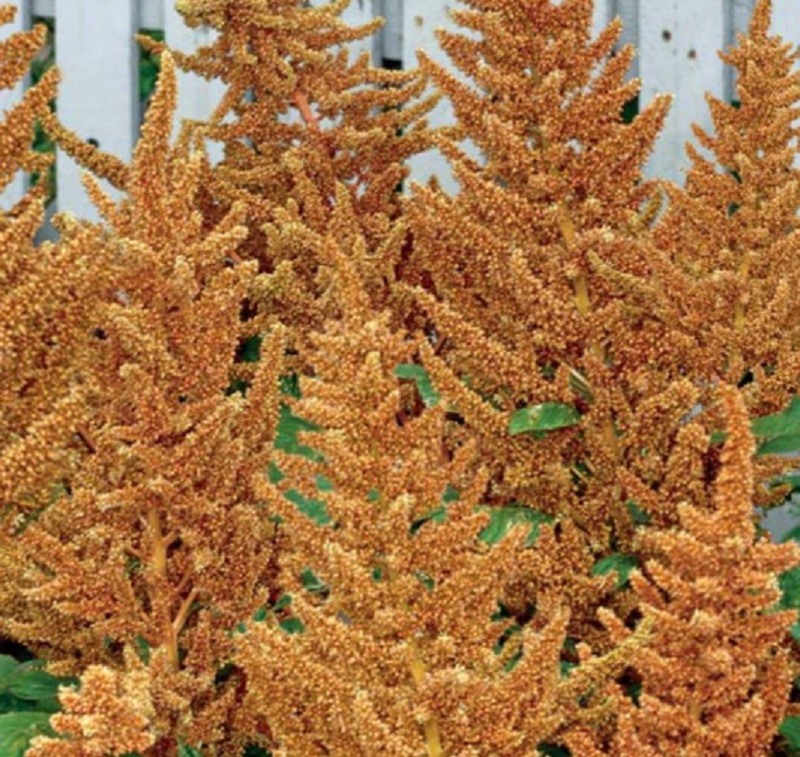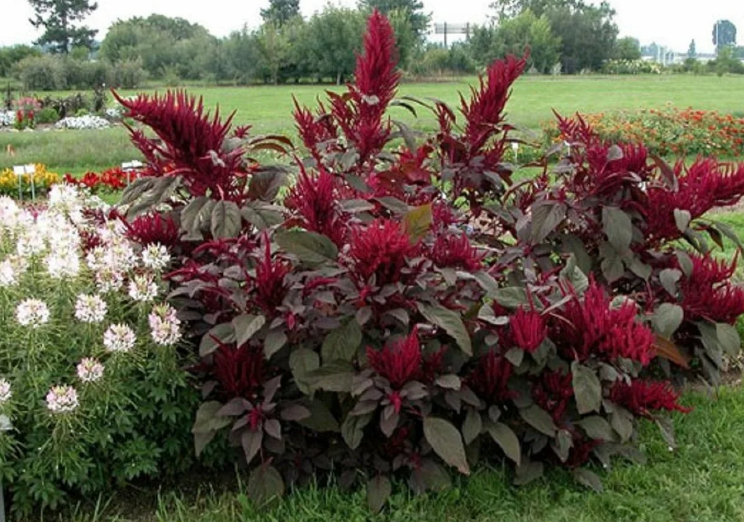Content
Amaranth paniculata is a common annual plant from the Schiritsaceae family with powerful erect stems and oval red-brown leaves. Due to its high decorative value, the plant is actively used for decorating personal plots and creating bouquets, and its rich vitamin and mineral composition allows it to be used in folk medicine.
Description of amaranth paniculata
The plant, whose natural habitat covers the eastern and western regions of Asia, belongs to the genus Amaranth and is known as scarlet or paniculata. Powerful, erect, fleshy, grooved, reddish annual stems stretch up to 1.5 m in height and are covered with short pile of varying thickness.
The elongated ovate leaves of amaranth are attached to long petioles and are colored brownish-red.

The top of the plates is pointed, the base is wedge-shaped
A distinctive feature of the plant is paniculate, purple-red inflorescences with spike-shaped, pointed branches. The apical spike is longer than the lateral ones. The linear awl-shaped bracts are larger than the perianth with five lanceolate lobes.

Dark brown-red seeds up to 1.5 mm long ripen in a box that opens across.
Useful properties of amaranth paniculata
Chiritsa leaves are rich in pectin, ascorbic acid, carotenoids, polyphenols, amino acids and microelements. They serve as a source of boron, barium, nickel, iron, tryptophan, lysine, rutin, folic acid and cystine. Amaranth paniculata leaves contain 30% more protein than wheat and rice.
Ashiritsa seeds are rich in triglycerides, micro- and macroelements, as well as vitamins A, B, C, E and P. They have high nutritional value and are used to produce oil, bran, flour and starch.

Sprouted acorn seeds contain five times more antioxidants than unsprouted seeds.
Thanks to such a rich vitamin and mineral composition, paniculate amaranth is successfully used in folk medicine. Infusions and decoctions are prepared from the seeds, leaves and roots of the plant, used to treat colds, diabetes, cardiovascular diseases, genitourinary dysfunction, endometriosis, keloid scars, scars, bedsores, burns, fungal infections, dermatitis, gastritis and colitis.
Amaranth seed oil has antioxidant properties and contains many rare and essential substances, including lysine.It helps improve the absorption of calcium in the body and strengthen hair follicles, and also serves as a prevention of hypertension and coronary heart disease.
Like any other product, ashiritsa can bring not only benefits, but also harm. Products made from the leaves, seeds and rhizomes of amaranth are contraindicated for:
- duodenal ulcer;
- duodenitis;
- chronic indigestion;
- diarrhea;
- atherosclerosis;
- dyspepsia;
- urolithiasis;
- chronic and acute pancreatitis.
Flowering time of amaranth paniculata
The annual flowering begins in mid-June and continues throughout the summer. The process stops only with the onset of autumn frosts.
Varieties of paniculate amaranth
The plant is represented by several varieties. They all have individual characteristics and differ from each other in size and color.
Amaranth paniculata Mermaid
A highly decorative, fast-growing variety is valued for its drought resistance and is characterized by lush and long-lasting flowering. The paniculate species of Rusalka amaranth has powerful, erect stems up to 1 m high.

Large burgundy leaves and small flowers of Rusalka amaranth are collected in half-meter inflorescences
Amaranth paniculata Openwork
A light-loving variety with an erect stem stretching up to 120 cm in height. It produces strong side shoots and has green leaves.

The annual amaranth openwork is valued for its long flowering, which stops after the onset of noticeable frosts.
Amaranth paniculata Red Cathedral
Tall annual with spike-shaped inflorescences consisting of small burgundy flowers and powerful erect stems densely covered with large ovate leaves. The Red Cathedral variety is characterized by late flowering.

Amaranth is valued for its resistance to most diseases
Amaranth paniculata Red torch
Decorative herbaceous annual with a powerful 40-centimeter stem and erect dark purple inflorescences. With the arrival of cold weather, its large, elongated ovoid leaves become multi-colored, and the inflorescences acquire a chocolate brown hue.

The plant does not tolerate even slight frosts; it is grown mainly in regions with a warm, mild climate.
Amaranth paniculata Cherry jam
Tall herbaceous annual with strong thick shoots and large red-violet elongated ovate leaves supported on long petioles. The powerful cascading inflorescences of Amaranth paniculata Cherry jam are burgundy in color and are classified as spike-shaped panicles.

The variety is characterized by good heat resistance and is valued for its immunity to various diseases and pests
Amaranth paniculata Cherry velvet
Decorative herbaceous perennial with dense dark green or bottle foliage and large pyramidal inflorescences of an exotic cherry-purple hue. The plant is easy to care for and is easily spread by birds.

In terms of reproduction speed, Cherry velvet amaranth competes with meadow grasses and flowers
Planting amaranth paniculata
Purple acorn is propagated in two ways - seed and seedlings. Each of them has its own characteristics.
Growing paniculate amaranth from seeds
The site for planting acorn grass has been prepared since the fall. The soil is dug up to a depth of 20 cm and fertilized with compost and humus at the rate of 5 kg/m2. In the spring, the soil is dug up again and fed with mineral compounds.Planting begins when the threat of night frosts disappears and the soil warms up to above-zero temperatures to a depth of at least 12 cm.
To make work easier, amaranth seeds are mixed with sand and sown in rows in holes 50 mm deep. The first shoots appear after about 10 days. At first they grow very slowly.

Over time, the intensity of seedling mass growth increases
In Siberia and other regions with a cold climate, it is impossible to wait for the seeds to appear and ripen, therefore, mainly early ripening varieties of acorns are grown here.
Growing from seedlings
This method is suitable for growing any variety of agaric. To prevent the roots from growing prematurely, the seed is placed in containers at least 10 cm high.
Boxes or plastic containers are filled with purchased soil and seeds are scattered over it. A thin layer of soil is evenly distributed on top and moistened with a spray bottle.

The containers are covered with film to create a greenhouse effect and placed in a warm, well-lit place
When shoots appear, the film is removed from the container. To obtain strong and healthy seedlings, after the formation of the first leaf, each plant is transplanted into a small flowerpot, at the bottom of which there are drainage holes to remove excess moisture.
14 days before planting seedlings in open ground, they begin to harden them. To do this, flowerpots are taken out into the yard or loggia.

Time spent on the street starts from a quarter of an hour a day and gradually increases
Features of care
Throughout the growing season, the paniculate type of amaranth is regularly watered. In spring, the soil under the plant is moistened weekly. In hot weather, the amount of watering is increased.
In the first weeks after planting the plant in open ground, the soil under it is regularly weeded and loosened. When the acorn grass begins to actively grow, it will crowd out the weeds, and fighting them will become irrelevant.
Amaranth is fed 3-4 times during the growing season. To do this, add ash and mullein to the ground under the acorn grass. Fertilize the plant early in the morning, after the main watering.
Diseases and pests
The paniculate type of amaranth belongs to the category of hardy plants that are immune to most infections and pests. The greatest danger to acorn grass comes from aphids and weevils, which slow down the growth of the annual plant and are easily destroyed by insecticides.
If the soil is systematically waterlogged, the plant is at risk of root rot, often aggravated by fungal infections. Amaranth can be saved by correcting the irrigation regime and treating it with fungicides.
Application of amaranth paniculata
The paniculate type of amaranth is highly decorative and is actively used in floristic and landscape design.

Shchiritsa looks impressive in rocky gardens and various flower beds, flower beds and mixborders

Dwarf varieties are used to create ridges and borders

Tall varieties are used to decorate the walls of houses, fences and outbuildings.
Conclusion
Amaranth paniculata is a popular herbaceous annual with high decorative qualities and unique healing properties.It is undemanding in care and is valued for its exotic appearance and long-lasting flowering.








